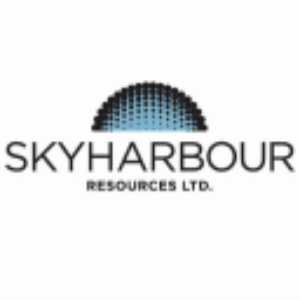Skyharbour Announces ANT Survey Prior to Upcoming Drill Program as well as Summary of 2024 Drilling to Date at Russell Lake Uranium Project, Northern Saskatchewan
Rhea-AI Summary
Skyharbour Resources has completed an Ambient Noise Tomography (ANT) survey at its Russell Lake Uranium Project ahead of a planned fall drill program. The survey, using Fleet Space Technologies' ExoSphere technology, targeted the Grayling and Fork areas where previous drilling found high-grade uranium.
The company reported results from its 2024 drilling program, highlighting a significant discovery in hole RSL24-02 which yielded 0.721% U3O8 over 2.5 metres, including 2.99% U3O8 over 0.5 metres at 339.6 metres depth. The total drilling campaign comprised 5,152 metres across ten holes in two phases.
Skyharbour is now fully funded and permitted for a follow-up fall campaign of approximately 7,000 metres, split between Russell (4,500m) and Moore (2,500m) projects.
Positive
- None.
Negative
- None.
News Market Reaction 1 Alert
On the day this news was published, SYHBF declined 3.63%, reflecting a moderate negative market reaction.
Data tracked by StockTitan Argus on the day of publication.
Vancouver, BC, Oct. 24, 2024 (GLOBE NEWSWIRE) -- Skyharbour Resources Ltd. (TSX-V: SYH) (OTCQX: SYHBF) (Frankfurt: SC1P) (the “Company”) is pleased to announce that it has carried out an Ambient Noise Tomography (ANT) survey prior to the upcoming fall drill program, and has received the remaining results from the second phase of the program earlier this year at the 73,294 hectare Russell Lake Uranium Project (“Russell” or the “Project”). The Project is
Russell Lake Project Location Map:
http://www.skyharbourltd.com/_resources/images/SKY-RussellLake-20220325-Inset.jpg
ANT Survey and Fall Drill Campaign:
In preparation for the upcoming drill program at Russell, Skyharbour has completed an Ambient Noise Tomography (ANT) survey at the Russell Lake Project. The survey used Fleet Space Technologies' ExoSphere technology to acquire 3D passive seismic velocity data over the highly prospective Grayling and Fork target areas, where previous drilling has intersected high-grade uranium mineralization. The ANT technology has been successfully employed in mapping significant sandstone and basement structures and associated alteration zones related to hydrothermal fluids pathways in the Athabasca Basin.
The results from this survey will be used to further refine drill targets for the fall 2024 drill program at Russell. Skyharbour is fully funded and permitted for the follow-up fall drill campaign consisting of approximately 7,000 metres of drilling at its main Russell and Moore Projects, with 2,500 metres of drilling at Moore and 4,500 metres of drilling at Russell.
Summary of Russell 2024 Winter and Spring Drilling:
Drilling at Russell earlier this year was completed during two separate phases of drilling, with a total of 5,152 metres drilled in ten holes during the winter and spring of 2024. The first phase of drilling consisted of a total of 3,094 metres in six holes, which was previously reported, while the second phase of drilling consisted of 2,058 metres of drilling in four holes. During Phase One, the best intercept of uranium mineralization to date on the property was intersected in RSL24-02, which returned a 2.5-metre-wide intercept of
Phase One Winter Drilling at Russell:
The first phase of drilling focused on drill testing the newly identified Fork Target area related to and south-southwest of the Grayling Zone. One hole during Phase One was drilled to test an East Grayling target, approximately 3 kilometres to the southeast of the Fork Target area. Results of this first phase of drilling are detailed in Skyharbour’s news release dated July 19th, 2024, titled: “Skyharbour Drills New Discovery at Russell Project with High-Grade Uranium Mineralization Up to
Grayling and Fork Target Areas – Drill Collar Map:
https://www.skyharbourltd.com/_resources/maps/2024-Fork-DDH-Location-Map-Zoomed-new-002.jpg
The highlight of the drilling in Phase One was hole RSL24-02, which tested a separate northeast- to east-trending conductor at the Fork Target area and intersected significant mineralization in the sandstone near the unconformity. The hole returned
2024 Fork Target Drill Hole Location Map:
https://www.skyharbourltd.com/_resources/maps/2024-Fork-East-Grayling-Drill-Hole-Location-Map-NR-new-002.jpg
As previously reported, follow-up drilling both down dip and 175 metres along strike to the west of RSL24-02 in holes RSL24-04 and -05 intersected prospective sandstone and basement geology and significant uranium and pathfinder geochemistry. Hole RSL24-04 deviated significantly and missed the intended target.
Phase Two Spring Drilling at Russell:
During the second phase of drilling at Russell Lake, three holes totaling 1,649 metres (holes RSL24-07 to -09) were drilled at the regional MZE target area, approximately 10 km northeast of the Fork target. Holes RSL24-07 and -08 were drilled to completion, while hole RSL24-09 was abandoned approximately 70 metres above the unconformity due to faulted ground conditions. The final hole of the second phase of the 2024 winter/spring drilling program, RSL24-10, was drilled at the Fork target area but missed the primary target due to excessive deviation during drilling.
The MZE target lies on trend from Denison’s Wheeler River Project M-Zone, where historical drilling intersected significant uranium mineralization. More recent drilling by Denison in 2020 at the M-Zone encountered additional uranium mineralization with significant faulting, core loss, geochemical anomalies, and radioactivity. Like the Grayling Zone, the mineralization at M-Zone is hosted by a graphitic thrust fault within a significant magnetic low. It is also noted that lineaments (cross structures) associated with Denison’s Phoenix and Gryphon uranium deposits may trend onto the Russell Lake property within the MZE target area, further enhancing the prospectivity of this target.
2024 MZE Drill Hole Location Map:
https://www.skyharbourltd.com/_resources/maps/2024-MZE-Drill-Hole-Location-Map-results-002.jpg
Hole RSL24-07 was drilled to test the northern extension of a magnetic low hosting the MZE Zone. A moderate to strongly bleached sandstone column was intersected down to a silicified and brecciated unconformity at 506.4 metres. Basement rock consisted of strongly chloritic, hematized, and clay-altered, paleoweathered pelitic gneiss and granitic pegmatite to 531.0 metres, containing a clay-altered and chloritic fault gouge at 526.6 to 531.0 metres. Interlayered moderately to strongly silicified granitic pegmatite and biotite-rich pelitic gneiss are present throughout the remainder of the hole. The sandstone column returned mostly background geochemistry, aside from anomalous As (12.9 ppm Aspartial) in a composite sample at a depth of 70-80 metres. The basement geochemistry returned anomalous U (≤124 ppm U total and prospective U/Th ratios ≤6.89) at the lower contact of a faulted pelitic gneiss, in addition to anomalous B (≤2,180 ppm B) within pegmatites and structurally disrupted, weakly graphitic metasediments.
Hole RSL24-08 tested the northwestern extension of the MZE Zone. Strongly bleached sandstone with minimal visible structures was drilled until the intersection with the unconformity at 510.9 metres. Below the unconformity, purple, hematized, chloritized, and paleoweathered graphitic pelitic gneiss was intersected until 533.3 metres. Intensely chloritized, clay-altered, weakly radioactive pegmatite with graphitic pelitic gneiss lenses was observed down to 546.6 metres, followed by a steeply faulted pelitic gneiss with chlorite/clay alteration occurring to 557.5 metres. Mixed pelitic gneiss and granite extended through the remainder of the hole. The PIMA SWIR spectroscopy results indicated that the basal 90 metres of sandstone is strongly illitic, which is considered highly prospective for uranium mineralization. Background sandstone geochemistry was present until 10.0 metres above the unconformity, with the sandstone below 500.0 metres anomalously enriched in B (≤774 ppm B). The boron anomaly is related to the presence of dravitic clay as identified in the corresponding PIMA data. The basement returned highly anomalous U (≤394 ppm Utotal) accompanied by anomalous B (≤607 ppm B), within an interval of strongly argillized, weakly graphitic pelitic gneiss. The basement samples with the highest U contents also have high U/Th ratios (≤18.76), which suggests the uranium is of hydrothermal origin.
Hole RSL24-09 was drilled to test the MZE conductor and McDougall Fault at the unconformity southwest of the 2011 MZE holes. RSL24-09 was lost at 432.0 metres (approximately 60 to 70 metres above the expected unconformity) within strongly bleached, moderately desilicified/friable sandstone. Variably bleached and desilicified sandstone was intersected throughout, hosting multiple small fracture zones. While the sandstone geochemistry returned values within background levels, a highly prospective illitic clay signature was present from 385.0 metres until the end of the hole.
Russell Lake Project Historical Summary:
The Russell Lake Project is a large, advanced-stage uranium exploration property totalling 73,294 hectares strategically located between Cameco’s Key Lake and McArthur River Projects and adjoining Denison’s Wheeler River Project to the west and Skyharbour’s Moore Uranium Project to the east. The northern extension of Highway 914 between Key Lake and McArthur River runs through the western extent of the Property and greatly enhances accessibility, while a high-voltage powerline is situated alongside this road and the western edge of the property south of Key Lake. Skyharbour’s acquisition of Russell Lake creates a large, nearly contiguous block of highly prospective uranium claims totalling 108,999 hectares between the Russell Lake and the Moore uranium projects.
There has been historical exploration carried out at Russell Lake. However, most of it was conducted before 2010, prior to the discovery of several major deposits in and around the Athabasca Basin. In 2023, Skyharbour’s inaugural diamond drilling program tested several Fox Lake Trail targets and the Grayling Zone. Significant uranium mineralization was intersected in the majority of holes at the Grayling Zone over a strike length exceeding one kilometre. Drill hole RSL23-01 intersected one of the better drill results from the project, returning a 5.9 metre wide intercept of
Several notable exploration targets exist on the property, including the Grayling Zone, the M-Zone Extension target, the Little Man Lake target, the Christie Lake target, the Fox Lake Trail target and the newly identified Fork Zone target. More than 35 kilometres of largely untested prospective conductors in areas of low magnetic intensity also exist on the Property.
QA/QC:
All drill intervals above are downhole lengths. Sampling procedures and QA/QC protocols for geochemical results are as follows. All drill core samples selected for analysis are shipped to the Saskatchewan Research Council Geoanalytical Laboratories (SRC) in Saskatoon, Saskatchewan, under the care of Skyharbour personnel, for preparation, processing, and multi-element analysis by ICP-MS and ICP-OES using total (HF:NHO3:HClO4) and partial digestion (HNO3:HCl), boron by fusion, and U3O8 wt. % assay by ICP-OES using an ISO/IEC 17025:2017 accredited method. Assay samples are primarily chosen based on downhole probing radiometric equivalent uranium grades and scintillometer (Radiation Solutions RS-125) peaks, with additional samples taken above and below the unconformity and covering structures and alteration of interest in both the sandstone and basement. All assay sample intervals comprise 0.5-metre metres of continuous half-core split in the field using a manual core splitter; one half of the split core is retained in the core box, while the other half is sent to SRC for geochemical analysis. In addition to sampling all mineralization, at least one to two shoulder samples (each 0.5 metre wide) are collected both above and below any mineralized interval. Mineralized and shoulder samples may additionally be selected for density determination using the lost wax method at SRC. Skyharbour also collects systematic composite samples in the sandstone, for which small chips of core are collected at the end of every row of core in the core box over a 10 metre wide interval and combined into one sample before being sent to the SRC for analysis. The systematic sandstone samples are then analyzed by the same analytical methods previously described for the assay samples. SRC is an ISO/IEC 17025/2005:2017 accredited and Standards Council of Canada certified analytical laboratory. Blanks, certified standard reference materials, (including high-grade uranium standards), and sample repeats are inserted into the sample stream at regular intervals by both Skyharbour and SRC in accordance with Skyharbour’s quality assurance/quality control (QA/QC) procedures. Geochemical assay data are subject to verification procedures by qualified persons employed by Skyharbour prior to disclosure. Skyharbour also carries out sampling for clay minerals analysis, which involves collecting a 3-5 cm wide piece of core at the desired sample depth. Samples are taken systematically every 10 metres in the sandstone, with selected samples also being taken in areas of prospective alteration. These samples are then transported by Skyharbour personnel to Rekasa Rocks Inc. in Saskatoon, Saskatchewan, where they are analyzed by Short Wavelength Infrared Reflectance (“SWIR”) using a Portable Infrared Mineral Analyzer (“PIMA”) to determine the clay species present in the sample and their relative proportions. Several samples from each batch of samples are subject to repeat analysis by Rekasa in accordance with Skyharbour’s quality assurance/quality control protocols.
Qualified Person:
The technical information in this news release has been prepared in accordance with the Canadian regulatory requirements set out in National Instrument 43-101 and reviewed and approved by David Billard, P.Geo., a Consulting Geologist for Skyharbour as well as a Qualified Person. Mr. Billard has verified the data disclosed, which includes a review of the sampling, analytical and test data underlying the information and opinions contained herein.
About Skyharbour Resources Ltd.:
Skyharbour holds an extensive portfolio of uranium exploration projects in Canada's Athabasca Basin and is well positioned to benefit from improving uranium market fundamentals with twenty-nine projects, ten of which are drill-ready, covering over 580,000 hectares (over 1.4 million acres) of land. Skyharbour has acquired from Denison Mines, a large strategic shareholder of the Company, a
Skyharbour also has joint ventures with industry leader Orano Canada Inc., Azincourt Energy, and Thunderbird Resources (previously Valor) at the Preston, East Preston, and Hook Lake Projects respectively. The Company also has several active earn-in option partners, including CSE-listed Basin Uranium Corp. at the Mann Lake Uranium Project; CSE-listed Medaro Mining Corp. at the Yurchison Project; TSX-V listed North Shore Uranium at the Falcon Project; UraEx Resources at the South Dufferin and Bolt Projects; and TSX-V listed Terra Clean Energy (previously Tisdale) at the South Falcon East Project which hosts the Fraser Lakes Zone B uranium and thorium deposit. In aggregate, Skyharbour has now signed earn-in option agreements with partners that total over
Skyharbour's goal is to maximize shareholder value through new mineral discoveries, committed long-term partnerships, and the advancement of exploration projects in geopolitically favourable jurisdictions.
Skyharbour’s Uranium Project Map in the Athabasca Basin:
https://www.skyharbourltd.com/_resources/images/SKY_SaskProject_Locator_2024-02-14_V2.jpg
To find out more about Skyharbour Resources Ltd. (TSX-V: SYH) visit the Company’s website at www.skyharbourltd.com.
SKYHARBOUR RESOURCES LTD.
“Jordan Trimble”
______________________
Jordan Trimble
President and CEO
For further information contact myself or:
Nicholas Coltura
Investor Relations Manager
Skyharbour Resources Ltd.
Telephone: 604-558-5847
Toll Free: 800-567-8181
Facsimile: 604-687-3119
Email: info@skyharbourltd.com
NEITHER THE TSX VENTURE EXCHANGE NOR ITS REGULATION SERVICES PROVIDER ACCEPTS RESPONSIBILITY FOR THE ADEQUACY OR ACCURACY OF THE CONTENT OF THIS NEWS RELEASE.
Forward-Looking Information
This news release contains “forward‐looking information or statements” within the meaning of applicable securities laws, which may include, without limitation, completing ongoing and planned work on its projects including drilling and the expected timing of such work programs, other statements relating to the technical, financial and business prospects of the Company, its projects and other matters. All statements in this news release, other than statements of historical facts, that address events or developments that the Company expects to occur, are forward-looking statements. Although the Company believes the expectations expressed in such forward-looking statements are based on reasonable assumptions, such statements are not guarantees of future performance and actual results may differ materially from those in the forward-looking statements. Such statements and information are based on numerous assumptions regarding present and future business strategies and the environment in which the Company will operate in the future, including the price of uranium, the ability to achieve its goals, that general business and economic conditions will not change in a material adverse manner, that financing will be available if and when needed and on reasonable terms. Such forward-looking information reflects the Company’s views with respect to future events and is subject to risks, uncertainties and assumptions, including the risks and uncertainties relating to the interpretation of exploration results, risks related to the inherent uncertainty of exploration and cost estimates and the potential for unexpected costs and expenses, and those filed under the Company’s profile on SEDAR+ at www.sedarplus.ca. Factors that could cause actual results to differ materially from those in forward looking statements include, but are not limited to, continued availability of capital and financing and general economic, market or business conditions, adverse weather or climate conditions, failure to obtain or maintain all necessary government permits, approvals and authorizations, failure to obtain or maintain community acceptance (including First Nations), decrease in the price of uranium and other metals, increase in costs, litigation, and failure of counterparties to perform their contractual obligations. The Company does not undertake to update forward‐looking statements or forward‐looking information, except as required by law.









